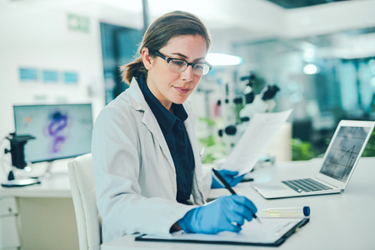Pros And Cons Of In Silico Target-Drug Dynamics
By Suleiman Badmos, Insilico Scientific Inventions and Development Limited, and Farouq Busari, University of Auburn

In the evolving landscape of drug discovery and development, in silico modeling has no doubt shifted from being a complementary research tool to a critical component in early-stage development pipelines. Within the plethora of in silico modeling tools, target-drug dynamic simulations that use digital models to explore how a potential therapeutic agent interacts with its biological target have gained significant traction.
Historically, understanding how drugs interacted at their sites of action was nearly impossible without experimental testing. Traditional drug discovery pipelines relied heavily on the use of animal models and presumptions that often contributed to high drug attrition rates in clinicals.1
The advent of in silico modeling provided avenues for understanding target-drug dynamics and heralded a new dawn in rational drug discovery. This changed the narrative by enabling detailed predictions of target-drug interactions, which accelerated the pace of drug candidate screening.2 However, as the enthusiasm for in-silico modeling continues to grow, there is a need for critical appraisal, particularly from the standpoint of researchers in the pharma ecosystem. This enthusiasm comes with a bigger responsibility: critically assess where we are, what works, and where the risks lie especially in in silico target-drug dynamics.
What Are Target-Drug Dynamics In The In Silico Context?
Target-drug dynamics refer to the computational approaches, such as molecular docking, molecular dynamics simulations, free energy calculations, and AI/ML-augmented models that attempt to predict not just whether a ligand binds but how it actually behaves (e.g., conformational changes, stability, kinetics, binding) in or around the binding site. These methods bridge molecular structure, thermodynamics, and sometimes kinetics, thereby enabling a deeper understanding and appreciation of drug action before advancing to wet lab synthesis and assays.
The Advantages
The adoption of in silico target-drug dynamics comes with many pros, which are being continually explored.
It has been noted that one of the important advantages of this technique is the fact that it affords us with mechanistic insights early on in the drug discovery pipeline.3 Molecular dynamics (MD) simulations and free energy perturbations allow one to observe interaction patterns like hydrogen bonds and binding site flexibility. These patterns cannot be captured by static docking protocols. They enable identification of potential off-target interactions or induced fit, which helps refine leads early.
There is reduced cost and speed in lead prioritization. The screening of large libraries via virtual screening and short MD or enhanced sampling can help to avoid synthesis of many less viable candidates. A study by Islam et al. 2025 where they looked at in-silico approaches for drug designing technology demonstrated how the adoption of these tools led to faster lead identification and significantly reduced reliance on expensive lab work.4
Many failures in drug discovery stem from poor absorption, distribution, metabolism, excretion, or toxicity (ADMET). Recent works by Tran et al. 2023 highlight how AI models are becoming increasingly effective in the prediction of absorption and permeability.5 Similarly, their paper, Recent Studies on Drug Prediction, showed how improvements in prediction of distribution parameters can help weed out compounds that are likely to accumulate or be cleared too fast in the body.6
The application of this technique to a large pool of compounds makes it another efficient tool in drug discovery. Virtual screening, whether structure or ligand based, allows evaluation of millions of compounds. With the improved computational resources and cloud/cluster access, sophisticated MD simulations ensembles are becoming feasible earlier in the pipeline of drug discovery.
Embracing the use of target-drug dynamics would result in fewer unnecessary synthesis and wet-lab experiments. This would lead to reduced use of potentially hazardous chemicals, lower waste, and even a smaller carbon footprint.
Limitations And Challenges
One of the foremost limitations of in silico target-drug dynamics is model accuracy and structural uncertainty. Many targets do not have high-resolution crystal structures. The use of homology models or low-quality structures may lead to inaccurate docking or MD results.
Computational cost and resource intensity is another challenge. While docking is relatively cheap, accurate MD simulations require substantial computational power. Some other aspects, like free energy calculations or models that capture kinetic aspects (on/off rates), can further increase demands.
The risk of data bias and overfitting in AI models is another point of caution. AI/ML models are only as good as the data set with which they were trained. Biases such as most data sets being biased toward well-studied targets and limited chemical space can lead to overoptimistic predictions. Also, lack of negative data (non-binders or off-targets) can distort model behavior.7
Despite the enormous benefits of in silico target-drug dynamics, excellent simulations cannot fully account for the complexity of living systems as several other factors interplay. Factors like cell permeability and off-target interactions may not translate to clinical reality.
It is common practice for regulatory agencies and other stakeholders to require reproducible and validated experimental data. In silico approaches are useful guides but may be less accepted in lieu of empirical proof. Also, reproducibility of simulation parameters, software versions, force fields, and many others can influence outcomes, which makes comparison across studies difficult.
Best Practices And Recommendations
To maximize benefits and reduce the risks when using in silico target-drug dynamics:
- Validate the input structures carefully: The use of high-resolution structures is essential. In cases where homology models are adopted, there should be verification via multiple models and, where possible, validation against known ligands.
- It is important to combine static and dynamic approaches. Docking can be used to filter what would be followed by MD or enhanced sampling for top candidates. Also, free energy and kinetic estimation may offer better predictive power when feasible.
- Incorporation of negative data, like non-binders and off-target ligands, will improve model robustness and reduce bias.
- There is a need to cross-validate early with experiments. It has been noted that even small-scale experimental data can guide and correct computational models.
- Sharing of documents and protocols should be encouraged as this provides a basis for reproducibility. Details of force fields, solvent models, time scales, initial/final conformations, and software versions allow researchers to reproduce results under the same conditions.
- Stay up to date on AI/ML advances to continue to appraise the adoption of a technique or approach.
Conclusion
In silico target-drug dynamics no doubt offer unprecedented speed, scalability, and cost-efficiency, but there is an attendant risk factor of overreliance, regulatory uncertainty, and data bias. Looking forward, hybrid workflows, which combine AI/ML, physics-based simulation, and experimental feedback, will likely dominate. Also, advances in computing, more open structural data, and more detailed kinetic modeling will be important in narrowing the gap between in silico prediction and in vivo reality. The reality remains: the challenge is not simply whether to adopt these technologies but how to use them responsibly and efficiently.
References
- Dobie, R. (2024, December 12). The reality of drug discovery and development. Centre for Human Specific Research. https://www.chsr.org/insights/the-reality-of-drug-discovery-and-development
- Ekins, S., Mestres, J., & Testa, B. (2007). In silico pharmacology for drug discovery: methods for virtual ligand screening and profiling. British journal of pharmacology, 152(1), 9–20. https://doi.org/10.1038/sj.bjp.0707305
- Roney, M., & Mohd Aluwi, M. F. F. (2024). The importance of in-silico studies in drug discovery. Intelligent Pharmacy, 2(4), 578–579. https://doi.org/10.1016/j.ipha.2024.01.010
- Islam, A., Jena, D., Mondal, N., Teli, A., & Mondal, S. M., & Gautam, M. K. (2025). In-silico Approaches for Drug Designing Technology: Bridging Discovery and Development. Current Drug Discovery Technologies, 22(5).
- Tran, T. V. V., Tayara, H., & Chong, K. T. (2023). Recent Studies of Artificial Intelligence on In Silico Drug Absorption. Journal of Chemical Information and Modeling, 63(20):6198-6211.
- Tran, T. V. V., Tayara, H., & Chong, K. T. (2023). Recent Studies of Artificial Intelligence on In Silico Drug Distribution Prediction. International Journal of Molecular Sciences, 24(3), Article 1815.
- Chen, H., Zhang, Z., & Zhang, J. (2021). In silico drug repositioning based on the integration of chemical, genomic and pharmacological spaces. BMC Bioinformatics, 22(1), Article 52. https://doi.org/10.1186/s12859-021-03988-x
About the Authors
 Suleiman Badmos is a medicinal chemist, science communicator, and researcher with expertise in in-silico drug discovery, molecular docking, molecular dynamics simulations, and bioactivity profiling. He holds a master’s degree in organic chemistry from the University of Ibadan, Nigeria. His research spans antiviral, antimicrobial, and anticancer drug discovery, with an emphasis on integrating green chemistry principles and sustainable approaches to therapeutic innovation.
Suleiman Badmos is a medicinal chemist, science communicator, and researcher with expertise in in-silico drug discovery, molecular docking, molecular dynamics simulations, and bioactivity profiling. He holds a master’s degree in organic chemistry from the University of Ibadan, Nigeria. His research spans antiviral, antimicrobial, and anticancer drug discovery, with an emphasis on integrating green chemistry principles and sustainable approaches to therapeutic innovation.
In addition to his laboratory and computational research, Badmos is dedicated to translating complex scientific concepts into accessible knowledge for diverse audiences. His work reflects a commitment not only to scientific excellence but also to fostering broader understanding and responsible application of cutting-edge drug discovery methods.
 Farouq Busari is a doctoral researcher in chemistry and biochemistry at Auburn University. He holds a BSc in industrial chemistry. His work focuses on enzyme mechanisms, drug discovery, and structural biology, with research exploring hormone-regulating enzymes through protein engineering, computational modeling, mass spectrometry, and X-ray absorption spectroscopy. During his master’s at the University of Ibadan, he also contributed to natural product chemistry, phytochemistry, and antimicrobial discovery, blending computational and experimental approaches.
Farouq Busari is a doctoral researcher in chemistry and biochemistry at Auburn University. He holds a BSc in industrial chemistry. His work focuses on enzyme mechanisms, drug discovery, and structural biology, with research exploring hormone-regulating enzymes through protein engineering, computational modeling, mass spectrometry, and X-ray absorption spectroscopy. During his master’s at the University of Ibadan, he also contributed to natural product chemistry, phytochemistry, and antimicrobial discovery, blending computational and experimental approaches.
Busari has authored peer-reviewed publications, presented at international conferences, and received various honors, including the NOBCChE Tier 1 Grant, the University of Ibadan Graduate Travel Award, and selection to the NOBCChE Leadership Academy.
